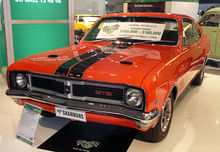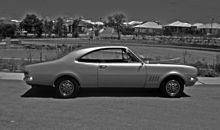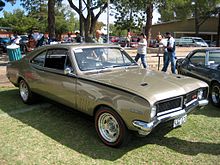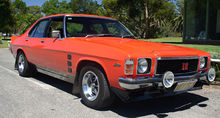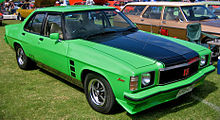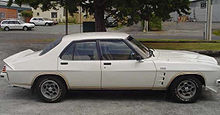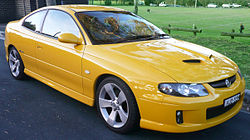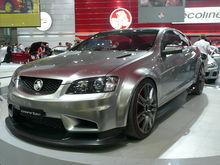- Holden Monaro
-
Holden Monaro 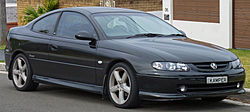
Manufacturer Holden Production 1968–1977
2001–2005Body style 2-door coupé
2-door hardtop
4-door sedanRelated Holden Kingswood
Holden Premier
Chevrolet SS
Holden Limited Edition
Holden GTS
Holden Commodore
Chevrolet Lumina
Pontiac GTO
Vauxhall Monaro
HSV GTO Coupe
HSV GTS Coupe
HSV Coupe4The Holden Monaro is an automobile that was produced by GM Holden Ltd, an Australian subsidiary of General Motors, between 1968 and 1977 and between 2001 and 2005. Since 1968, three generations of the Monaro have been produced.
Contents
First generation (1968–1971)
First generation[1] 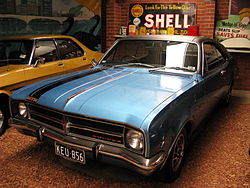
1968 Holden HK Monaro GTS coupe.Production 1968–1971 Engine L6 161 in3 (2.6 L) (base model)
L6 186 in3 (3.0 L) (GTS with an uprated 186S only)
V8 253 in3 (4.2 L)
V8 307 in3 (5.0 L)
V8 308 in3 (5.0 L)
V8 327 in3 (5.3 L)
V8 350 in3 (5.7 L)HK
Named after the Monaro region in New South Wales (although pronounced differently), the Monaro was introduced in July 1968 as a two-door pillarless hardtop coupe available in three models: the basic Monaro coupe, Monaro 'GTS' coupe and Monaro 'GTS 327' coupe. The GTS versions had "full instrumentation" which included a tachometer mounted on the centre console. This proved to be a bad location as the drivers knee would obstruct the view and it often rattled (Spotlight on Holden Monaro Page 6-7). The cars could be ordered with a choice of six cylinder engines of 161 cu in (2,640 cc) capacity (base only) or two versions of 186 cu in (3,050 cc) capacity (GTS with the uprated 186S only), or a 307 cu in (5,030 cc) capacity Chevrolet-sourced V8. The exclusive 'GTS 327' model was powered by the 250 bhp (186 kW) Chevrolet 327 cu in (5,360 cc) V8.
In early 1969 the HK Monaro range was awarded Wheels magazine's Car of the Year for 1968.
HT
In June 1969 the HK Monaro was replaced by the facelifted HT Monaro.[2] The 'GTS 327' became the 'GTS 350' with the replacement of the Chevrolet 327 in3 (5.4 L) V8 by the 300 bhp (224 kW) Chevrolet 350 in3 (5.7 L) V8. There was also an automatic version of the 'GTS 350' introduced which used a lower power version of the 350 in3 (5.7 L) engine coupled to a 2-speed Powerglide transmission. HT Monaro also marked the phasing out of the 5.0 litre Chevrolet V8 and the introduction of two locally made V8 engines, the 253 in3 (4.2 L) and 308 in3 (5.0 L). Late in the HT model run, a new locally-produced 3-speed automatic transmission, the Trimatic, was offered as an option, although it was not available on the 'GTS 350'.
The HT Monaro can be distinguished from the HK by the adoption of plastic grilles (previously metal), a round speedometer instead of "strip" style allowing for bringing the tachometer into the main instrument cluster instead of on the floor console, rubber front suspension bushes instead of the HK's sintered bronze, and larger taillights where the turn indicators also wrapped around the now slightly undercut edges. Bodywork 'go-faster' stripe designs (delete options) varied for each series; HK stripes were offset to the driver's side of the bonnet (hood) and bootlid (trunk), the HT had two broad stripes down the centre of the car. HT also had twin air scoops / vents incorporated into their bonnet, which served no real purpose in delivering air into the engine bay.
HG
Released on the 26 July 1970, the HG Monaro was the last of the original coupe design concept. HG had cleaner lines with brightwork reduced and some re-designed. The HG sported different striping (delete options) which were known as "sidewinder" stripes which rang along the top edge of the fenders, under the windows and finishing just before the rear pillar. The "Monaro" badge on both rear pillars was introduced to all models. For the HG GTS, the "GTS" badges now featured black paint fill, received new black-out paint on rocker panels, with the GTS 350 getting bold treatment with new "sidewinder" stripes and bonnet scoop black-outs. "GTS 350" designations now featured gutsier decals on the fenders and boot lid. Wheel arch moldings were deleted on all models. The "GTS 350" models no longer had the 350 Chevrolet badge on the fender, but rather a bold decal stating "350" as well as blackouts that covered the air-vents on the bonnet. The GTS badge originally above the gills in the fenders would be removed and would now be black instead of red (with the badges being placed on the passenger side of the grille and boot). The taillights had a cleaner look and the grille was redesigned.
Most mechanical specifications remained the same as HT series, with the exception of Monaro GTS (non-350), which had softened suspension, resulting in a smoother ride. Manual HG GTS 350 retained the suspension from the HT GTS 350. Other upgrades included thicker (HT GTS 350 style) power front disc brakes, now standard for all V8 and the 6-cylinder Monaro GTS. The HG would be the final model for the generation and the last to use the original body shell.[3]
South African market
HT series Monaros were assembled in South Africa from imported parts by General Motors South African (GMSA) at the Port Elizabeth assembly plant.[4] Later the HG series Monaro was assembled and sold in South Africa badged as the Chevrolet SS.[4] At this time GMSA had made a decision to market most of its products as Chevrolets. The Chevrolet SS had revised front styling unique to that model, incorporating four headlights and large turn indicators in the front edge of the fenders above the bumper. The Holden Monaro and Chevrolet SS models were both available with Holden 308 in3 (5.0L) and the Chevrolet 350 in3 (5.7 L) engines.[4] South African sales totalled 1828 Monaros and 1182 SS models.[4]
Second generation (1971–1977)
Second generation 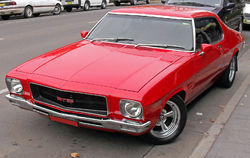
Holden HQ Monaro GTS 350 coupe.Production 1971—1977 Engine L6 173 in3 (2.85L) (base model)
L6 202 in3 (3.3 L) (LS model)
V8 253 in3 (4.1 L)
V8 308 in3 (5.0 L)
V8 350 in3 (5.7 L) (GTS model)HQ
A completely new generation body design emerged with the HQ series in July 1971, including the new Monaro 'LS' (commonly believed to mean "Luxury Sports") model. There were no longer any six-cylinder versions of the Monaro GTS, just 253 or optional 308 V8s or the top level GTS350 coupe. The base model Monaro standard engine was enlarged to 173 cu in (2,830 cc) whilst the Monaro LS had a broad spectrum of engine options from a 202 cu in (3,310 cc) six to the 350 cu in (5,700 cc) V8. The new coupe design had a much larger rear window and a squarer rear quarter window; it was somehow seen as not as sporty looking compared to the earlier HK-HT-HG series, but is often now considered one of the best looking body designs to come from an Australian producer.
Up until 1973, the HQ Monaro GTS did not wear any body stripe ornamentation and the 350 cubic inch (5.74 L) Chevrolet Small-Block V8 engine was a little less potent than in previous HT/HG versions, especially with the optional Turbo-hydramatic 3-speed automatic transmission. This, and the fact that the same 350 engine was also available as on option in the
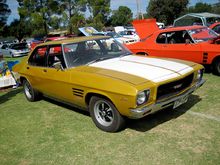 1971–1974 Holden HQ Monaro GTS sedan in South Australia.
1971–1974 Holden HQ Monaro GTS sedan in South Australia.
large Statesman luxury sedan, probably contributed to a downgrade of the Monaro GTS range in muscular image terms, as did the replacement of the bigger coupes with the six-cylinder Holden Torana GTR XU-1 as the chosen GM car for Australian touring car racing. The introduction of bonnet and bootlid paint-outs in 1973 coincided with the release of the HQ Monaro GTS in four door sedan configuration. It is generally considered that Holden created the bold contrasting paint-outs in order that the new Monaro GTS sedan would not be mistaken for the humble Kingswood sedan upon which it was based.
The continued erosion of the GTS350 cache was compounded by the deletion of specific '350' decals on the post-1973 cars, with all Monaro GTS coupes and sedans now being externally labelled with the generic HQ series 'V8' bootlid badge. In the final year of HQ production, i.e. 1974, the manual transmission version of the GTS350 was discontinued and sales of the automatic version were minimal prior to the engine option being quietly and unceremoniously deleted.
A factory 350 HQ GTS Monaro is very valuable today, with a 350 sedan fetching as much as $50,000, and close to $100,000 for a 350 GTS Coupe.
HJ
A heavy facelift and some model rationalisation was applied to the HJ Monaro, which was released in October 1974.[5] The 350 V8 engine option and the base Monaro coupe were both discontinued.[5] The Monaro GTS continued to be available as a coupe or sedan with 253 cu in (4,150 cc) V8 power, or the optional 308 cu in (5,050 cc) V8 engine. The GTS sedan was now a model of its own - in HQ the GTS sedan was an optioned Kingswood. The Monaro LS coupe also continued within the range, but still with the 3.3 litre six-cylinder engine as its base power unit.
The body paint-outs were discontinued in the HJ Monaro GTS range, but for the first time, the Monaro could be dressed up with optional front and rear spoilers. It seemed that Holden were no longer interested in promoting the Monaro GTS coupe as a performance machine and this became all the more obvious with the HJ coupe series having retained the HQ model's rear body styling.
The HJ Monaro LS coupe is close to being the rarest regular production car ever made in Australia with only 337 units [6] produced. The HJ Monaro GTS coupe was discontinued during 1975 due to falling demand,[5] 606 examples having been produced.[6]
HX
New emissions regulations heralded the mildly facelifted HX Monaro GTS sedan, announced in July 1976.[7] The HX was quite distinguishable, with liberal splashes of black paintouts contrasted against a range of bold body colours, and a choice of traditional chrome or body painted bumper bars.
Holden HX Limited Edition
Holden found that it held more coupe bodyshells than could easily expended as "spare parts". The solution was the Holden Limited Edition, or 'LE', which was released on 27 September 1976.[8] All were painted an exclusive metallic colour called LE Red. The LE was not badged or officially referred to as a Monaro.[9] The LE was an amalgam of prestige and surplus parts (including an eight-track cartridge player well after cassette tapes were common), in effect a combination of Monaro GTS and Statesman Caprice components. The LE had a price tag to match: $11,500. The cars were built at the now-defunct Pagewood (Sydney) plant. Production totalled 580 vehicles.[10] The distinctive honeycomb wheels fitted to the LE, which resembled those of the second generation Pontiac Firebird, were created by a plastic mould adhered to the outside of convential steel wheel rims.
Holden HZ GTS
Although the Monaro name had survived into 1977 as the HX Monaro GTS sedan, the coupe configuration was no longer in production and Holden decided to delete the Monaro name altogether from the new Holden HZ range.[11] With the development of Radial Tuned Suspension, Holden transformed the bland characteristics of their full-size sedans and introduced a sporting variant called simply Holden GTS.[12] Released on 5 October 1977,[13] the HZ GTS featured a four headlight grille, front and rear air dams, four wheel disc brakes, sports wheels and a 4.2 litre V8 engine as standard equipment.[12] The optional 5.0 litre V8 [12] became standard in June 1978.[13] But, with the November 1978 introduction of the new mid/full-size VB Commodore sedan and its availability with V8 engine power, the days of the HZ series appeared numbered. Production of the GTS ceased in December 1978, [13] an estimated 1,438 having been built.[13]
Ultimately, the VB Commodore proved very popular in both six-cylinder and V8 form, such that all full-size HZ Holdens passenger cars were phased out of production in 1980. Remnants of the H-series lived on in the Holden WB series commercial vehicle range and in the revamped Statesman WB sedans until 1985.
VH
The possibility briefly existed in the early 1980s for a revival of the Monaro badge based on a combination of the Holden VH Commodore and the Opel Monza with serious exploration of the concept and a Monza was shipped to Australia by Peter Brock but the project was shelved as it was a busy time at Holden with engineering work being done of Statesman and Gemini revamps and the launch of the JB Camira.[14]
Third generation (2001–2005)
Third generation Production 2001 - 2005 Engine V6 supercharged 3.8 L (232 in3) (CV6 model 2001-2004)
V8 5.7 L (346 in3) (CV8 model)Transmission 6-speed manual
4-speed automaticV2 / VZ
Some 20 years had passed before the Monaro reappeared in the form of a Holden Commodore Coupé prototype, codenamed 'Matilda', that was shown at the Sydney Motor Show in 1998. Using the existing Holden Commodore, already based on the Opel Omega B modified chassis, Journalists quickly christened it the Monaro, encouraging Holden to build it. Public interest in the car grew and orders came flooding in. Eventually, Holden took the Matilda and redesigned it for production and by 2001, the V2 series Monaro was launched after General Motors spent A$60 million over a 22-month gestation period (although 12 to 18 were targeted). It was available in CV6 (production ceased in mid 2004) and CV8 models with a supercharged 3.8 L V6 and a 5.7 L Gen III V8, with a choice of a 6 speed manual or 4 speed automatic gearbox. A series 2 model debuted in early 2003 with a revised dashboard from the VY series Commodore, a new wheel design and some colours dropped and new ones added. The CV6 model was dropped after disappointing sales (reputedly 10 times as many Monaros were built as CV8s) when a Series 3 model appeared in 2004.
Two special edition CV8-R Monaros were released, the first in a grey colour and the second in a more muted red. Each had special wheels and other distinguishing features.
In late 2004, Holden introduced the VZ range of Commodore vehicles which in 2005 were upgraded to feature the 6.0 litre L76 V8 engine in SS sedans and other variants. The Monaro CV8 was similarly upgraded and also received revised front and rear bumper assemblies, to be now referred to as the VZ Monaro CV8. The revised rear bumper and new ducted bonnet pressing would soon find their way onto the export Pontiac GTO. However, in July 2005 Holden announced that production of the current generation Monaro CV8 would soon be coming to an end. A run of 1100 of a limited-edition model, called the CV8-Z, was produced to farewell the legendary Monaro name, much as had been done with the LE coupe back in 1976. The CV8-Z had unique features including special wheels and a sunroof along with a choice of body colours, including a bold new orange/gold metallic called 'Fusion'.
The last Holden Monaro-badged coupe was purchased by Emerald, Queensland businessman Darryl Mattingley for A$187,355.55— around three times the normal retail price, on 19 February 2006. The car was bought through eBay,[15] with the money going to the Leukemia Foundation, setting an Australian eBay record for highest price to date in the process. Mattingley, a huge Ford collector, has stated that his only Holden will not be registered, but will make appearances at auto shows.
Despite an end to production of the Holden Monaro-badged coupe it remained in production for HSV and for export markets until 14 June 2006 when the last model, a Pontiac GTO, quietly rolled off the production line bound for the US.[16]
Holden Special Vehicles
An HSV version (not called Monaro, but simply Coupe) in 'GTO' 255 kW (347 PS; 342 bhp) through 297 kW (404 PS; 398 bhp) and 'GTS' 300 kW (408 PS; 402 bhp) tuned by Callaway) versions debuted soon after Holden's release of the V2 Monaro editions. Due to high cost and low sales, the HSV 'GTS Coupe' was later dropped, but in its place in 2004 there appeared a 270 kW four-wheel drive version called 'Coupe4'.
The highest-spec HSV Coupe conceived was the HRT 427 (Holden Racing Team 427 cu in (7,000 cc)). This car used the 427 cu in (7,000 cc) C5R Chevrolet racing engine, based on the GM LS7, modified by HRT and HSV to suit the Monaro. The 2002 HRT 427 featured a full carbon fiber body, a heavy-duty 900Nm clutch mated to a custom T56 six-speed manual gearbox hand built by Tremec for HSV, two Sparco Pro 2000 seats, a half roll cage, fully adjustable dampers on double 'A' arm aluminum front suspension, AP racing six-piston racing brakes, and ram air induction, a Motec instrument panel, and weight reduction bringing the car's weight down to just 1575 kg (3472 lb).[17] It produced 417.6 kW (560 bhp) at 6000 rpm, a top speed of 299.3 km/h (186 mph) and could sprint to 100 km/h (62 mph) in under four seconds. After it became apparent to Holden that the high-spec HRT 427 couldn’t be built in such limited quantities for the asking price, the project was eventually canceled with deposits returned to eager buyers. As a result, only two concept HRT 427's exist, each of which cost about $500,000 to build. One is not for sale and is slated to remain with the Holden concept vehicle collection. In April 2008, the other HRT 427 was sold to the Cairns car collector Shawn "Chooka" Ryan for the record-breaking price of $920,000, making it the most expensive Australian car ever sold.[18] In June 2010, however, the car was re-sold at auction in Sydney to an anonymous Queensland buyer at the far lower price of $350,000.[19]
A 427 Monaro GT racecar was built by Garry Rogers Motorsport, and went on to win the 2002 and 2003 Bathurst 24 Hour races. This car is often confused for being the 'track' version of the HRT 427, but the racing program headed by then-Holden Motorsport Manager John Stevenson was announced many months before the HRT 427 was revealed to the press and public.
In fact, the first GRM-built car in 'nuclear banana' yellow underwent shakedown laps at Calder Park before a half day's testing at Winton wearing #427. It was then shown to the media and public at the Bathurst 1000 race a week before the HRT 427 was unveiled at the Sydney Motor Show, Garth Tander driving a lap of the Mt Panorama circuit in the rain - Holden Motorsport's promotion of the 'rival' 24 Hour race having bought promotional track time from the 1000 event organisers, not pleasing V8 Supercar management. So as not to preempt the HRT 427's launch the following week, for its sneak Bathurst 1000 unveiling the yellow Monaro wore Tander's #34, the car returning to #427 for the 24 Hour race.
Export markets
The third generation Monaro was exported to several overseas markets. It was sold as a (right hand drive) in South Africa as the Chevrolet Lumina. It was also sold, in left hand drive, in the Middle East as the Chevrolet Lumina Coupe, and in the United States as the Pontiac GTO, reviving another classic muscle car icon. However, at least one commentator[20] has described it as a 'flop' because of its poor US sales. It was withdrawn from the US market in 2006, although a few were still on dealers' lots in 2007.
Pontiac GTO
Main article: Pontiac GTOComplaints from American consumers[21] about the Pontiac GTO's more modern styling saw the addition of two hood scoops in 2005 with the VZ series Monaro to recall the later muscle-car variants of the late 1960s' models; the hood scoops vent in cool air to the engine bay but do not directly feed the engine. In the eyes of the Australian press, the scoops have spoiled the lines,[22] while the American media seemed to accept them. The 2005 and 2006 GTO also received a Gen IV 6.0 L engine putting out 400 hp (298 kW); the Australian HSV GTO coupe got a similar engine in its Z series; and Vauxhall launched this as the Monaro VXR in the UK.
Vauxhall Monaro
The Monaro was also sold in the United Kingdom as the Vauxhall Monaro where it won Top Gear's best muscle car award.
Vauxhall offered the Monaro buyer a limited edition prior to discontinuation of the model: the VXR 500. A Harrop supercharger was installed onto the standard GM 6.0 LS2 engine by Vauxhall dealer Greens of Rainham[23] in conjunction with tuning firm Wortec[24], increasing power to 507 PS (373 kW; 500 bhp) and torque to 677 N·m (500 lbf·ft). In addition to this, a shorter gear linkage was added to enable quicker shifts. The resultant 0 to 62 mph (100 km/h) was 4.8 seconds.[25]
With the end of production, Vauxhall opted to replace the Monaro in 2007 with a version of the HSV Clubsport R8 4-door sedan. The new model sports sedan is simply referred to as the Vauxhall VXR8.
Concepts
Marilyn Monaro
The Holden Monaro convertible, codenamed 'Marilyn', was built as a fully operational one-off in 2004, and was never intended to reach production. Unusually for a Holden-badged concept, it was left hand drive.[26]
Coupe 60
Main article: Holden Coupe 60Built in 2008 but not approved by GM for Production.
References
- ^ Ewan Kennedy: Holden The Classic Models. Marque Publishing Company, Blakehurst 1997. ISBN 0-947079-55-6, p. 53-90.
- ^ Norm Darwin, Monaro Magic, 2010, page 39
- ^ Spotlight on Holden Monaro by Tony Davis
- ^ a b c d Norm Darwin, Monaro Magic, 2010, page 65
- ^ a b c Norm Darwin, Monaro Magic, 2010, page 139
- ^ a b Norm Darwin, Monaro Magic, 2010, page 140
- ^ Norm Darwin, Monaro Magic, 2010, page 153
- ^ Norm Darwin, Monaro Magic, 2010, page 163
- ^ Holden HX Limited Edition sales brochure H591 of July 1976
- ^ Norm Darwin, Monaro Magic, 2010, page 154
- ^ The GTS Lives On, Motor Manual, May 1978, page 32
- ^ a b c Holden HZ GTS sales brochure H666 of September 1977
- ^ a b c d Norm Darwin, Monaro Magic, 2010, page 169
- ^ Kenwright, Joe. "VH Monaro SS: Holden's Stillborn Supercar". Australian Muscle Car (Lane Cove: Chevron Publishing Group) (40): 34–44. ISSN 1039-4516.
- ^ Dowling, Joshua (2006-03-03). "Ford man buys last Monaro". drive.com.au. http://news.drive.com.au/drive/motor-news/ford-man-buys-last-monaro-20100824-13pjc.html.
- ^ Dowling, Joshua (2006-07-07). "The real last Monaro". drive.com.au. http://news.drive.com.au/drive/motor-news/the-real-last-monaro-20060707-13yjy.html.
- ^ "HSV HRT 427 Concept". Supercars.net. 2003-06-16. http://www.supercars.net/cars/2484.html. Retrieved 2010-12-28.
- ^ Skentzos, George (2008-04-04). "Australia’s most expensive car, the HRT 427 | Car Advice | Reviews". Car Advice. http://www.caradvice.com.au/11677/australias-most-expensive-car-the-hrt-427/. Retrieved 2010-12-28.
- ^ "$350k snares Holden HRT 427". carsguide.com.au. http://www.carsguide.com.au/site/news-and-reviews/car-news/350k_snares_holden_hrt_427?from=ms. Retrieved 2010-12-28.
- ^ Farago, Robert (2007-09-03). "General Motors Death Watch 144: Nolo Contendere". The Truth About Cars. http://www.thetruthaboutcars.com/general-motors-death-watch-144-no-lo-contendre/.
- ^ Sean Mattingly. "ULTIMATE PONTIAC GTO PICTURE SITE Monaro news #10". Ultimategto.com. http://ultimategto.com/monaro10.htm. Retrieved 2010-12-28.
- ^ McKinnon, Bill (2005-02-18). "New Car Road Test Holden VZ Monaro". http://news.drive.com.au/drive/new-car-reviews/holden-vz-monaro-20100824-13n9e.html.
- ^ [1] Greens of Rainham
- ^ [2] Wortec tuning
- ^ "Vauxhall Monaro VXR 500 vs Jaguar XKR". http://fifthgear.five.tv/jsp/5gmain.jsp?lnk=601&featureid=606.
- ^ "2004 Holden Monaro Marilyn Concept". Seriouswheels.com. http://www.seriouswheels.com/cars/top-2004-Holden-Monaro-Marilyn-Concept.htm. Retrieved 2010-12-28.
Holden, a subsidiary of General Motors, automobile timeline, 1948–present List of Holden vehicles
† HQ–WB Statesmans not marketed under the "Holden" brand, but rather the separate "Statesman" brand.Vauxhall Motors A subsidiary of General MotorsPassenger cars CurrentPast10-4 (1937–1947) · 12-4 (1937–1946) · 14-6 (1939–1948) · 14 and 14/40 (1922–1927) · 20/60 (1927–1930) · 23/60 (1922–1926) · 25 (1937–1940) · 25/70 (1926–1928) · 30/98 (1913–1922) · A-Type (1911–1914) · B-type (1911–1914) · C-Type (1911–1913) · D-type (1912–1922) · Belmont (1986-1991) · Calibra (1990-1997) · Carlton (1978–1994) · Cavalier (1975–1995) · Chevette (1975–1984) · Cresta (1954–1972) · Firenza (1970–1975) · Frontera (1991–2004) · Magnum (1973-1978) · Monaro (2001–2005) · Monterey (1994–1999) · Nova (1983-1993) · Omega (1994-2003) · Royale (1978-1986) · Senator (1978-1994) · Signum (2003-2008) · Vectra (1995-2008) · Velox (1948–1965) · Viceroy (1978-1982) · Victor (1957–1972) · Viscount (1966–1972) · Viva (1963–1979) · VX220 (2001-2005) · VX4/90 (1961–1972) · Wyvern (1948–1957)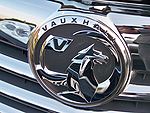
Commercial vehicles CurrentPastBedfordVauxhallConcept cars Divisions and subsidiaries People Other Categories:- Holden vehicles
- Vehicles introduced in 1968
- Coupes
- Muscle cars
- Cars of Australia
- Rear wheel drive vehicles
- Sports cars
Wikimedia Foundation. 2010.


